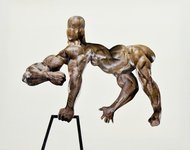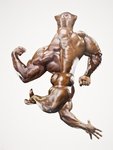BODY COLLAGES
Dimensions: 16"x20"
What can these bodies do?
There is a physicality in Branko Djuras' paintings, Body Collages, that undoes thinking. However, this physicality is not the same physicality captured through mere representation. It is easy enough to say Djuras' work represents society's obsession with the ideal body, after all Body Collages is composed of body-parts cut out from bodybuilding magazines. This physicality that undoes thinking is expressed in the interaction with the works. On encountering these works one becomes physical - one's eyes and correspondingly one's body move along the sinewy lines of the muscles that connect triceps to quadriceps to abdominals and so forth. We act out the movement that is suggested statically in the collages. Hence, these body-parts move us from mere viewers to figures in motion. We are decomposed to body-parts in motion that our minds cannot yet properly define.
As figures in motion we are confronted with the possibility that there are meanings created in this encounter with Body Collages that our minds cannot comprehend according to pre-established socio-cultural or political frameworks. The philosopher Gilles Deleuze wrote that there cannot be change in body without some sort of change in the mind. However, the body is capable of entering into relationships with itself or with other bodies that defy categories the mind has previously pre-conceived. To change a body's position, movements and relations in unfamiliar manners is to produce in thought something new, something that requires the mind to truly work out new modes of comprehension. The mind cannot remain at the same position while the body transforms. They transform together toward the formation of new concepts and new subjectivities.
Hence, the physicality produced here decomposes any Cartesian perspective an individual holds. What Djuras' bodies and our bodies can do is their ability to enter into relations that cannot be determined by the mind. Baruch Spinoza writes:
No one has yet come to know the structure of the body so accurately that he could explain all its functions... This shows well enough that the body itself, simply from the laws of its own nature, can do many things which its mind wonders at.
Insofar as the body undergoes non-telic changes, the mind, which is always trying to understand the body, is also capable of producing concepts that it cannot predetermined. The mind's capability to grasp the body and its own reality is non-telic. The mind no longer functions just as a repository and regurgitator of pre-established concepts and values; it is always in there with the corporeal forces amongst other forces renewing itself. The physicality in Djuras' collages undoes thinking so that thinking can really begin, so that subjectivities may be sustained by vitality. Thus, the politics in these works lay in the works' ability to make us think of the how bodies relate to each other and with the mind; or rather, how bodies and minds are united and moving towards states of being that cannot be defined by easy political frameworks. The politics of identity is politicised.
Patrick Foong Chan
1st February 2009, Vancouver































